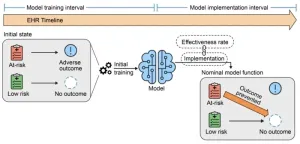(Press-News.org)
Researchers from the United States, Brazil, and Spain, including scientists with the Fralin Biomedical Research Institute at VTC, published an analysis in a special edition of the British Medical Journal with a timely and controversial recommendation: It’s time for an international shift in the way we think about ultra-processed food.
“There is converging and consistent support for the validity and clinical relevance of food addiction,” said Ashley Gearhardt, the article’s corresponding author and a psychology professor at the University of Michigan. “By acknowledging that certain types of processed foods have the properties of addictive substances, we may be able to help improve global health.”
While people can give up smoking, drinking, or gambling, they can’t stop eating, said co-author Alexandra DiFeliceantonio, assistant professor at the Fralin Biomedical Research Institute. The challenge, and the open and controversial question, is defining which foods have the most potential for addiction and why.
Their work was published Oct. 10 in Food For Thought, a special edition of the British Medical Journal, a high-impact publication and one of the world’s oldest medical journals.
DiFeliceantonio is also associate director of the Fralin Biomedical Research Institute’s Center for Health Behaviors Research and an assistant professor in the Department of Human Nutrition, Foods, and Exercise in the College of Agriculture and Life Sciences at Virginia Tech.
Not all foods have the potential for addiction, the researchers said.
“Most foods that we think of as natural, or minimally processed, provide energy in the form of carbohydrate or fat – but not both,” DiFeliceantonio said.
Researchers gave the example of an apple, salmon, and a chocolate bar. The apple has a carbohydrate to fat ratio of roughly 1-to-0, while the salmon has a ratio of 0-to-1. In contrast, the chocolate bar has a carbohydrate to fat ratio of 1-to-1, which appears to increase a food’s addictive potential.
“Many ultra-processed foods have higher levels of both. That combination has a different effect on the brain,” DiFeliceantonio said. Researchers also called for more study into the role of food additives used in industrial processing. Key takeaways from the analysis include:
Behaviors around ultra-processed food, which are high in refined carbohydrates and added fats, may meet the criteria for diagnosis of substance use disorder in some people. Those behaviors include less control over intake, intense cravings, symptoms of withdrawal, and continued use despite such consequences as obesity, binge eating disorder, poorer physical and mental health, and lower quality of life.
This global health challenge needs to consider geographic differences. In a review of 281 studies from 36 different countries, researchers found ultra-processed food addiction is estimated to occur in 14 percent of adults and 12 percent of children. In some countries, ultra-processed foods are a needed source of calories. Even within high-income countries, food deserts and other factors could limit access to minimally processed foods. People facing food insecurity are more reliant on ultra-processed foods, and therefore more likely to demonstrate food addiction, researchers noted.
Viewing some foods as addictive could lead to novel approaches in the realm of social justice, clinical care, and public policy. Policies implemented in Chile and Mexico – taxes, labelling, and marketing – are associated with decreases in caloric intake and purchases of foods high in sugar, saturated fat, and salt, for example. And in the United Kingdom, a salt-reduction program was associated with a decline in deaths from stroke and coronary artery disease.
The co-authors represent international expertise on food addiction, nutrition physiology, gut-brain reward signaling, food policy, behavioral addiction, and eating disorders. They call for more study and science surrounding ultra-processed foods,
“Given how prevalent these foods are -- they make up 58 percent of calories consumed in the United States -- there is so much we don’t know.” DiFeliceantonio said.
The researchers call for more study into such areas as: how complex features of ultra-processed foods combine to increase their addictive potential; better defining which foods can be considered addictive; differences among countries and communities, including disadvantaged communities; the value of public-health messaging; and clinical guidelines for preventing, treating, and managing addiction to ultra-processed foods.
In addition to Gearhardt and DiFeliceantonio, authors include Nassib B. Bueno, a professor at Universidade Federal de Alagoas in Brazil; Christina A. Roberto, associate professor in the Department of Medical Ethics and Health Policy at the University of Pennsylvania’s Perelman School of Medicine; and Susana Jiménez-Murcia and Fernando Fernandez-Aranda, both professors in the Department of Clinical Psychology at the University Hospital of Bellvitge in Spain.
END
Embargoed for release until 5:00 p.m. ET on Monday 9 October 2023
Annals of Internal Medicine Tip Sheet
@Annalsofim
Below please find summaries of new articles that will be published in the next issue of Annals of Internal Medicine. The summaries are not intended to substitute for the full articles as a source of information. This information is under strict embargo and by taking it into possession, media representatives are committing to the terms of the embargo not only on their own behalf, but also on behalf of the organization they represent.
----------------------------
1. History of parental infertility associated ...
Models built on machine learning in health care can be victims of their own success, according to researchers at the Icahn School of Medicine and the University of Michigan. Their study assessed the impact of implementing predictive models on the subsequent performance of those and other models. Their findings—that using the models to adjust how care is delivered can alter the baseline assumptions that the models were “trained” on, often for worse—were detailed in the October 9 online issue of Annals of Internal Medicine: https://www.acpjournals.org/doi/10.7326/M23-0949.
“We wanted to explore ...
Graphics
It's well-known that birds and other animals rely on Earth's magnetic field for long-distance navigation during seasonal migrations.
But how do periodic disruptions of the planet's magnetic field, caused by solar flares and other energetic outbursts, affect the reliability of those biological navigation systems?
University of Michigan researchers and their colleagues used massive, long-term datasets from networks of U.S. Doppler weather radar stations and ground-based magnetometers—devices that measure the ...
Charles Darwin said that evolution was constantly happening, causing animals to adapt for survival. But many of his contemporaries disagreed. If evolution is always causing things to change, they asked, then how is it that two fossils from the same species, found in the same location, can look identical despite being 50 million years apart in age?
Everything changed in the past 40 years, when an explosion of evolutionary studies proved that evolution can and does occur rapidly — even from one generation to the next. Evolutionary biologists were thrilled, but the findings reinforced the same paradox: If evolution can happen so fast, then why do most species on Earth continue to ...
Many species experience little to no change over long periods of time. Biologists often fall back on the same explanation for why this is true: that natural selection favors individuals with more moderate characteristics. Individuals with more extreme features — longer limbs, for example — have a disadvantage, while more moderate or average individuals are more likely to survive and reproduce, passing on their common features.
But new research from Washington University in St. Louis and the Georgia ...
Maize plants form special compounds derived from indole, the so-called benzoxazinoids. They are considered ecologically important because they act against a wide range of herbivores and reduce their feeding. Benzoxazinoids also exhibit antimicrobial properties and are thought to be involved in mediating plant-plant interactions. Their biosynthesis in maize has been known since the 1990s. Meanwhile, their biosynthetic pathway has been described in several grasses, but benzoxazinoids have also been found in other plant species. Their distribution is peculiar: While specialized metabolites often occur in specific evolutionary related plant species, benzoxazinoids ...
Scientists at the UCL Institute for Neurology have developed new tools, based on AI language models, that can characterise subtle signatures in the speech of patients diagnosed with schizophrenia.
The research, published in PNAS, aims to understand how the automated analysis of language could help doctors and scientists diagnose and assess psychiatric conditions.
Currently, psychiatric diagnosis is based almost entirely on talking with patients and those close to them, with only a minimal role for tests such as blood tests and brain scans.
However, ...
CHAMPAIGN, Ill. — According to a new paper, ancient Maya reservoirs, which used aquatic plants to filter and clean the water, “can serve as archetypes for natural, sustainable water systems to address future water needs.”
The Maya built and maintained reservoirs that were in use for more than 1,000 years, wrote University of Illinois Urbana-Champaign anthropology professor Lisa Lucero in a perspective in the Proceedings of the National Academy of Sciences. These reservoirs provided potable water for thousands to tens of thousands of people in cities during the annual, five-month dry season and in periods of prolonged ...
Hamilton, ON, Oct. 9, 2023 – New analysis of the remains of victims of the 1918 influenza pandemic, which killed an estimated 50 million people worldwide, contradicts the widespread belief the flu disproportionately impacted healthy young adults.
Because so many people fell ill so quickly, physicians at the time believed the healthy were as likely to die from the flu as those who had already been sick or frail. Despite numerous historical accounts, though, it turns out there is no concrete scientific evidence to support that belief.
Researchers at McMaster University and the University of Colorado Boulder ...
LOS ANGELES — Approximately 7% of Americans have had long COVID, a range of ongoing health problems experienced after infection and recovery from COVID-19. Symptoms can include fatigue, brain fog, headaches, chest pain, heart palpitations and more.
To date, there is no proven treatment for the syndrome, and the mechanisms that cause it are not fully understood.
Now, a new clinical trial from Keck Medicine of USC is investigating if a diet designed to lower inflammation may play a role in easing this often debilitating condition.
The premise of ...






